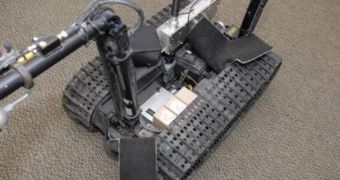The Talon is a small bomb-defusing and disposal robot that is operated by the Explosive Ordnance Disposal (EOD) crews in hostile environments, to identify and attempt to render nonoperational improvised explosives and other dangerous materials. But, whenever confronted with devices that have a very complex structure, they have to spend a lot of time defusing them, and their batteries often fail before the task is completed. Now, their Talon Battery Module (TBM) has finally received an upgrade.
The US Office of Naval Research (ONR) has recently commissioned a team of experts from the Pennsylvania State University Advanced Research Laboratory to come up with improvements on the lifetime of the existing batteries. The researchers have managed to come up with a system that enables the machine's power sources to operate 23 percent longer than in previous versions. Because Talon required a special kind of battery and adapter, the costs associated with operating it were also high.
Now, the Penn State Team replaced the special power source with a bank of four-to-six standard BB-2590 batteries, which can also be changed while the robot is online, without having to reboot it. This process is called hot-swapping and can currently be found on some mobile phones. Together with the improved battery health monitoring system, the new additions to the Talon ensure an operation cost lowered by 60 percent, as compared with the initial one.
“The TBM solution has become the new DOD [Department of Defense] standard for the Talon robot and all EOD robots in its class. It also showcases how we work to provide rapid solutions that directly benefit the work-life of Sailors and Marines. Typically, most of our requests come from the enlisted community who often are closest to the action and understand the technical issues involved,” Master Chief Petty Officer Stephen French, of ONR's TechSolutions branch, explains.
“Our job is to connect the science and technology community with the warfighter and the acquisition community. In this case, we provided the initial S&T funding to develop the proof of concept, and the Naval Explosive Ordnance Disposal Technology Division took the successful prototype into production as an acquisition program,” Master Chief Petty Officer Stephanie Everett, also from TechSolutions, adds.

 14 DAY TRIAL //
14 DAY TRIAL //